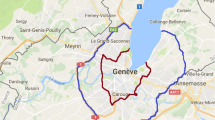Abstract
This paper proposes a demonstration project to test the effectiveness of “congestion pricing” in an urban area. It reviews the general theoretical case for such pricing and summarizes recent international interest in congestion pricing. Next, it sets forth the reasons why demonstration projects are needed, both to add to our knowledge about how effective congestion pricing may prove to be, and to address political and other public-acceptance barriers to implementation of the concept. The paper then defines a specific proposed test site for congestion pricing: a new toll road being planned for Orange County, California. It is proposed that instead of charging flat-rate tolls, the transportation agency could charge peak and off-peak tolls, increasing the level of the peak charge each year over a period of up to 10 years unless or until toll revenues decline below the levels forecast under the flat-rate toll alternative. Measurements of traffic flow and ride-sharing behavior would be made, as well as calculations of emission-reduction effects. The paper concludes with a brief discussion of marketing and political considerations involved in conducting such a demonstration.
Similar content being viewed by others
Abbreviations
- ARB:
-
Air Resources Board
- AVI:
-
Automatic Vehicle Identification
- CDMG:
-
Corridor Design Management Group
- HOV:
-
High-occupancy vehicle
- SJHTC:
-
San Joaquin Hills Transportation Corridor
- TCA:
-
Transportation Corridor Agency
- VMT:
-
Vehicle miles traveled
References
Air Resources BoardThe Air Pollution-Transportation Linkage, State of California. Sacramento, 1989, pp. 4–5.
California Report (1991)SCAG Finds South Coast Toll-Road Projects Conform with U.S. Clean Air Act, p. 4.
Cameron M (1991)Transportation Efficiency: Tackling Southern California's Air Pollution and Congestion, Environmental Defense Fund and Regional Institute of Southern California. Corridor Design Management Group (1990) Conceptual Design Report, San Joaquin Hills Transportation Corridor, TM-3-19.
Giuliano G & Small KA (1991) Subcenters in the Los Angeles Region,Regional Science and Urban Economics, Vol. 21, No. 2, pp. 163–182.
Keeler TE & Small KA (1977) Optimal Peak-Load Pricing, Investment, and Service Levels on Urban Expressways,Journal of Political Economy 85: 1–25.
Lee JH (1990) Fee Lanes at Both U.S. Borders,Los Angeles Times.
Poole, RW Jr (1990) Electronic Toll Collection: Key to Solving Urban Freeway Congestion, Policy Study #122, Reason Foundation, Santa Monica, CA.
Privatization Watch (1991) Congestion Pricing, Electronic Toll Collection Catching On in Norway, Netherlands, and U.K., p. 1.
Reinhardt WG (1990) Congestion Pricing Is Coming: The Question Is When and Where,Public Works Financing, pp. 7–14.
Resolution of the Board of Directors, Foothill/Eastern Transportation Corridor Agency and The San Joaquin Hills Transportation Corridor Agency to Establish High-Occupancy Vehicle Lanes, Resolutions Nos. 91F-03 and 91-S-03, 1991.
Wilbur Smith Associates (1991)HOV Analysis of the Transportation Corridors, Tasks 35 and 37A, (for Orange County Transportation Corridors Agencies).
Author information
Authors and Affiliations
Rights and permissions
About this article
Cite this article
Poole, R.W. Introducing congestion pricing on a new toll road. Transportation 19, 383–396 (1992). https://doi.org/10.1007/BF01098640
Issue Date:
DOI: https://doi.org/10.1007/BF01098640




